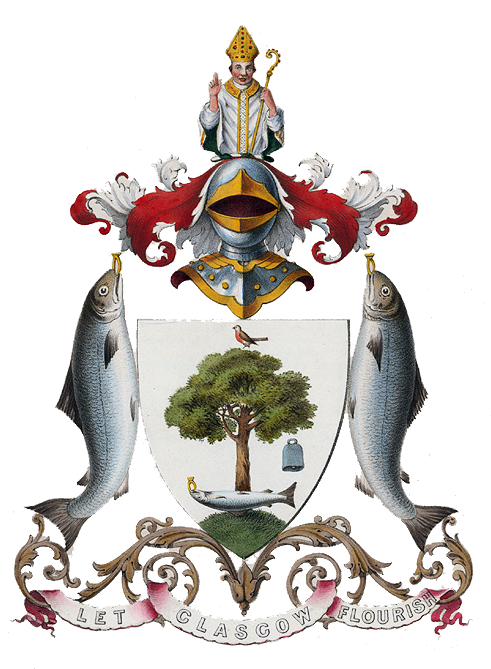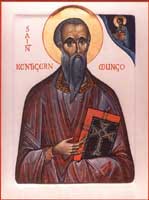Saint Mungo,
better known to us as
Saint Kentigern,
(Cyndeyrn Garthwys in
Welsh), was the late 6th century apostle of the
Brythonic Kingdom of what is now Strathclyde in modern
Scotland.
He is also founder of the city of Glasgow and its patron
saint.
 Saint Mungo appears in the crest of Glasgow's
coat-of-arms along
with his miracles.
Saint Mungo appears in the crest of Glasgow's
coat-of-arms along
with his miracles.
In Wales and the southern Brythonic regions of modern
England, he was known by his birth and baptismal name,
Kentigern. The Welsh Cyndeyrn,
from which it is derived, means 'chief prince' but the
meaning of its commonly attached suffix, 'Garthwys',
is unknown .
His pet name of Mungo in Scotland and the Northern
Brythonic areas of modern England, is derived from the
Brythonic word my-nghu which means 'dear one'. In the
northern parts of Cumbria can be found a many churches
dedicated to either Mungo or Kentigern. Our own Church
is dedicated to St Kentigern along with
St Columba who was an
acquaintance of Mungo's.
A 'Life
of Saint Mungo' was
written by the monastic hagiographer, Jocelin of Furness,
circa 1185. In it, Jocelin states that he rewrote the 'life'
from an earlier Glasgow legend which he combined with an
old Gaelic document. Part of an earlier 'life' can be
found in the British Library along with a later one,
attributed to John of Tynemouth and said to be based on
Jocelin's earlier work.
These stories have it that Mungo's mother, Thenaw, also
known as St. Thaney, who was the daughter of the
Brythonic king, Lleuddun, became pregnant after being
seduced by Owain mab Urien. King Lleuddun ruled in the
Haddington region of what is now Scotland, possibly the
Kingdom of Gododdin in the Old North. According to the
British Library manuscript, on hearing of her plight her
father became furious and had her thrown from the
heights of Traprain Law, an iron age hill fort some 4
miles east of Haddington in East Lothian. Fortunately
for her, she survived the fall but she was then left to
drift across the River Forth to Culross in Fife after
being abandoned in a coracle.
It was there that Mungo was born and where he was
brought up by Saint Serf who, at that time, was
ministering to the Picts of that area. It was St Serf
who gave him his now popular pet-name of Mungo.
Mungo began his missionary work, at the age of twenty-five,
concentrated along the Clyde, particularly on the site
of what is now Glasgow, an area to which Christianity
had already been introduced by Saint Ninian.
St Ninian's followers welcomed Mungo and arranged for
him to be consecrated bishop by a visiting Irish bishop.
He went on to build his church where the Clyde and the
Molendinar Burn meet, and it is here that the current
medieval cathedral now stands. He laboured in the
district for some thirteen years, where he lived a very
austere life in a small cell, making many converts by
his holy example and his preaching.
But then strong anti-Christian movement sprung up in the
region, led by King Morken, who expelled Mungo. He
travelled through Cumbria and on to Wales. He stayed for
a while with Saint David
at what is now St David's in modern Pembrokeshire before
moving on to Gwynedd where he founded a cathedral at
Llanelwy (modern day St Asaph). While here, he made a
pilgrimage to Rome, but then the new King of Strathclyde,
Riderch Hael, invited Mungo to return to his kingdom.
Mungo agreed and appointed Saint Asaph as Bishop of
Llanelwy in his place.
Although he spent some time in his Episcopal seat at
Hoddom in Dumfriesshire, where he evangelised the
district of Galloway, he eventually returned to
the
Glasgow area where a fairly large community grew up
around him, this eventually becoming known as Clas-gu
(meaning the 'dear family'). It was in nearby Kilmacolm
that he was visited by Saint
Columba, who at that time had been labouring in
Strathtay. The two saints are said to have embraced, had
a long conversation and then, before parting, exchanged
their pastoral staves.
In his old age, Mungo became increasingly feeble and is
said to have died in his bath, on Sunday the 13th of
January.
Tomb of St. Mungo in Glasgow Cathedral
